Looking for a rewarding and scenic mountain biking route in the Cairngorms National Park? The Burma Road is a local classic—and for good reason. Combining wide Highland views, a challenging ascent, and flowing countryside tracks, this 26-mile loop is a must-ride for adventurous cyclists. It’s suitable for both mountain bikes and gravel bikes and can be tackled straight from the doorstep of Fraoch Lodge, your base in Boat of Garten.
The Burma Road route is a fantastic way to see spectacular views of the Cairngorms and the picturesque countryside of the National Park. Graded hard and requiring a high fitness level to complete, this 26-mile cycling route is achievable in four to five hours.
Trekking over a mixture of tarmac, dirt, grass and rocky tracks makes sections of the trail challenging. And with a three mile extremely steep climb the initial part of the route can come across as particularly challenging. But, overall it is worth the initial exertion.
Distance: 26 miles / 41 km
Ascent: 2123 ft / 647 m
Time: 4–5 hours cycling time
Grade: Hard (fitness and bike handling required)
Bike type: Gravel or mountain bike
Best ridden: Late spring to autumn, when trails are dry and views are clearest
Approx. calorie count: 1800 kcal
The adventure begins right outside Fraoch Lodge, with a pleasant 6-mile warm-up ride to Aviemore, winding through moorland and pine forest. From there, follow the main road through Aviemore and across the A9 to begin the official Burma Road loop.
We can help with maps, gear checks, and even bike hire or guiding if you’d prefer extra support.
Once reaching Aviemore it’s as simple as following the main road through town, crossing the A9 and following a single tarmac road to the Scripture Union Centre at Alltnacriche. Having followed the route through a forest gate this is where things begin to get difficult.
Brace yourself—the first real test is a 3-mile steep climb beginning near the Scripture Union Centre at Alltnacriche. Even seasoned riders often hop off and push sections of this brutal gradient. But perseverance pays off: the higher you climb, the broader the views stretch, with the Cairngorm mountains unfolding behind you.
Don’t forget to pause, catch your breath, and soak in the scenery.
After reaching the high point, you’ll descend a rough, loose track with gravel and erosion channels that demand focus and steady control. Once you reach the bridge at the base, the trail levels and transitions into a more leisurely spin through Highland farmland and riverside paths.
Expect some boggy patches, grassy tracks, and a few gates, but this section is pure joy—especially with the hard climb behind you.
Once back on tarmac en route to Carrbridge, a 1-mile detour to Sluggan Bridge offers the chance to see an 18th-century arched bridge in an atmospheric setting. A photo opportunity not to be missed!
In Carrbridge, reward yourself with a well-earned pint and a snap of the iconic packhorse bridge, before heading the final 5 miles back to Fraoch Lodge via the signed National Cycle Route 7.
Fitness required: High
Bike type: Mountain or gravel with good tyres and gears
Water & snacks: Bring your own; no services on route
Weather: Check the forecast—conditions can change quickly
Navigation: You can download the route on Komoot but we highly recommend carrying an OS paper map as a back up in case of any phone failures. Always best to download your map on your phone, especially in more remote areas with intermittent or non-existent phone signal.
Phone signal: Intermittent, especially on the high section
Bike facilities at Fraoch Lodge: Secure storage, repair tools, drying room, packed lunches, and a hearty dinner to come home to!
No need for a car—ride out straight from your accommodation
Stay in a cycling-friendly lodge with route support and local knowledge
Relax post-ride with home baking, hot showers, and mountain views
Extend your stay with more Cairngorm rides like Glenmore Forest, Ryvoan Pass, or Speyside Way
More pictures and description of the route from Dave Banks
The route reviewed in The Herald newspaper
One of the most frequently asked questions from those joining our winter courses is: What if there is no snow? Although we can’t control the weather, we can almost guarantee there will be snow—especially on the high peaks during winter and early spring. However, for those still concerned, let us put your worries to rest.
The Cairngorms are home to Britain’s most permanent snow beds, some of which persist well into July or even early August. The high altitude and vast plateau of the Cairngorms make them a natural snow trap. Even in milder winters, the unique topography and wind patterns often ensure that snow is captured and retained in key areas. According to a study by the Royal Meteorological Society, the Cairngorm plateau experiences snow coverage for an average of 76 days per year, making it one of the most reliable locations for snow in the UK.
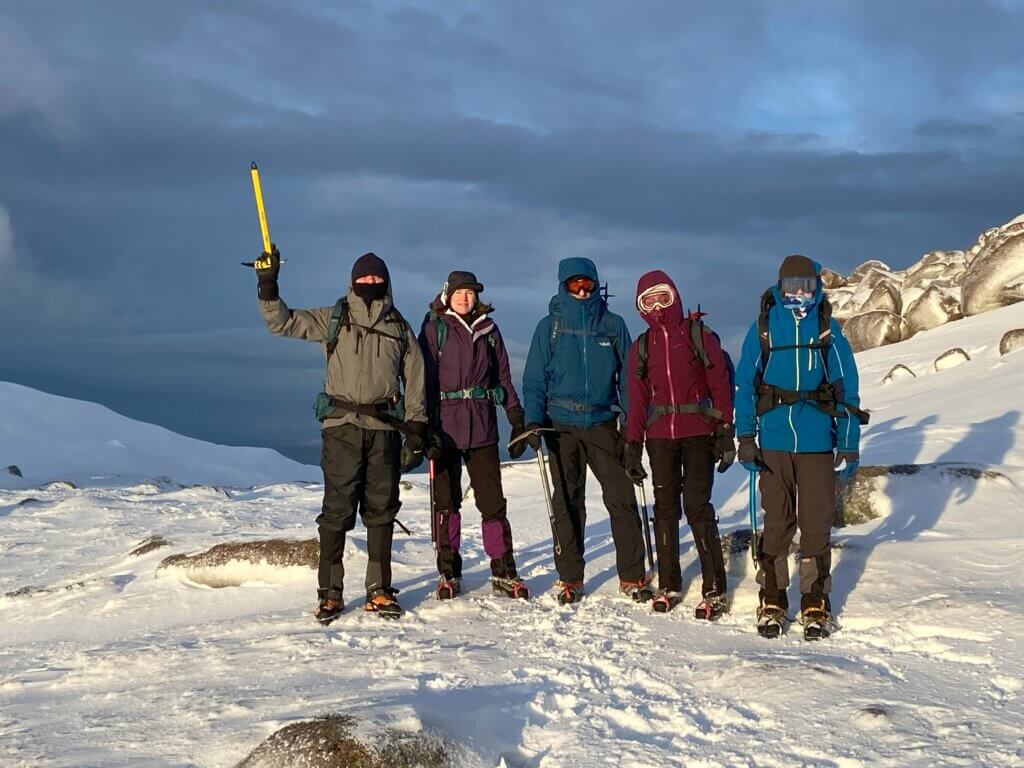
If, for some reason, the winter is unusually mild and snowfall is limited, it’s not the end of the world. Winter Skill courses with Scot Mountain Holidays are designed with flexibility in mind. Snow is just one of three critical factors that influence the course—the other two being wind (which facilitates snow drifting) and the expansive Cairngorm plateau (which helps to capture and hold snow).
Even if snow levels are lower, the skills taught during our courses remain relevant. In fact, hard, icy snow that forms after a thaw and subsequent freeze is often ideal for teaching crampon techniques. Fresh snow, while beautiful, doesn’t always add additional value to winter skills training.
In the 25 winter seasons that Scot Mountain Holidays has been running Winter Skills courses and hiking holidays, no course has ever been cancelled due to a lack of snow. This incredible track record highlights the reliability of the Cairngorms as a winter training destination.

While snow is a strong likelihood on the peaks where our courses take place, there are many other elements that make your experience memorable. Thick, deep snow can sometimes make routes more strenuous. On the other hand, mixed conditions offer a chance to practice a wide variety of essential skills, including:
These skills are just as important, if not more so, than simply walking on deep snow.
Remember, winter skills are about preparing you for all types of conditions you might encounter in the mountains. Snow is a bonus, but not a requirement. The camaraderie, expert instruction, and opportunity to immerse yourself in Scotland’s stunning winter landscape are what truly make Scot Mountain Holidays’ courses unforgettable.
So, whether the snow is thick, patchy, or concentrated in specific areas, rest assured that your Winter Skills course will still be an incredible and valuable experience. The Cairngorms’ rugged beauty, combined with expert guidance, ensures your time with us is both safe and rewarding. As one participant noted, “The course was transformational—I learned so much, regardless of snow levels.”
Join us this winter to develop your confidence and skills in one of the UK’s most dramatic settings. With Scot Mountain Holidays, you’re in expert hands, and no matter the snow conditions, we’ll make sure your time in the Cairngorms is unforgettable.
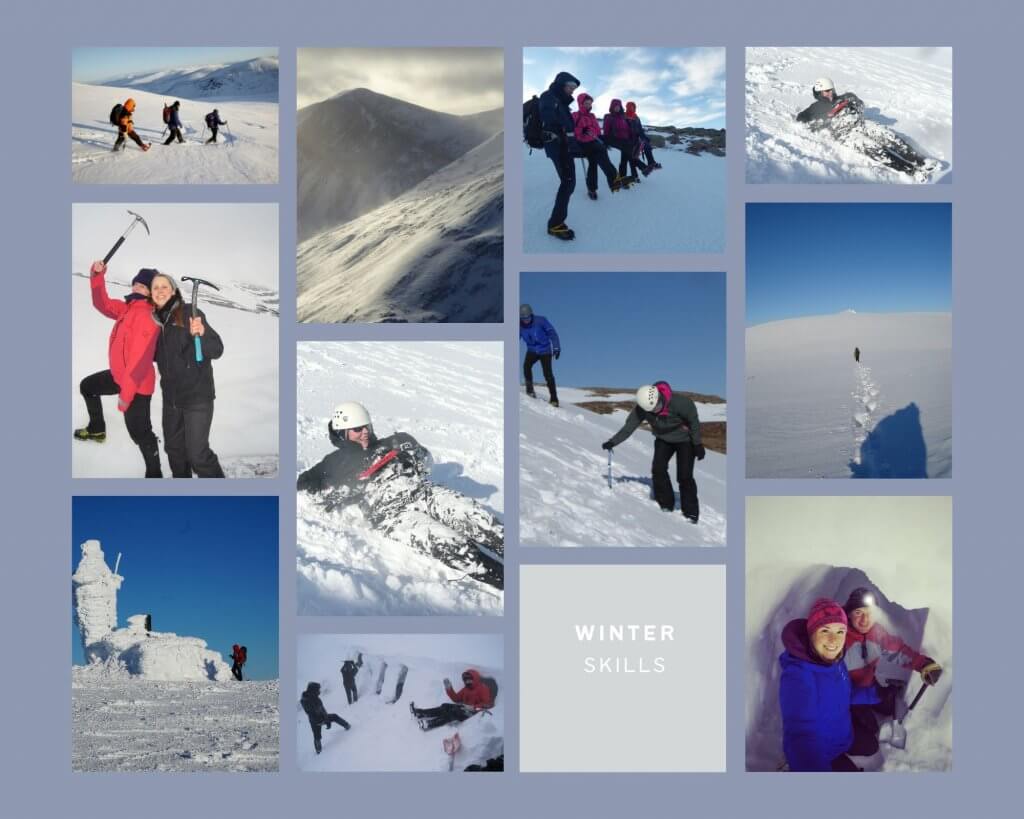
Scotland is a land of breathtaking beauty, with unique charms that shift with the seasons. While summer often steals the spotlight for visitors, winter remains a hidden gem offering raw beauty, crisp days, and unparalleled hiking experiences. If you’ve been hesitant to venture out during the colder months, let us convince you with five compelling reasons to go hiking in winter and join Scot Mountain Holidays for a trip you’ll never forget.
The peaks of Scotland are awe-inspiring at any time of year, but winter elevates their majesty to a whole new level. Snow-dusted summits, frost-kissed landscapes, and the clarity of winter skies combine to create an otherworldly spectacle. On clear days, the views are nothing short of magical, with the crisp air enhancing visibility and making every vista unforgettable. Scotland’s Cairngorms, for instance, often boast snow-covered peaks that rival the beauty of alpine ranges. Layer up, embrace the brisk wind, and let the beauty of hiking in winter reward your efforts.
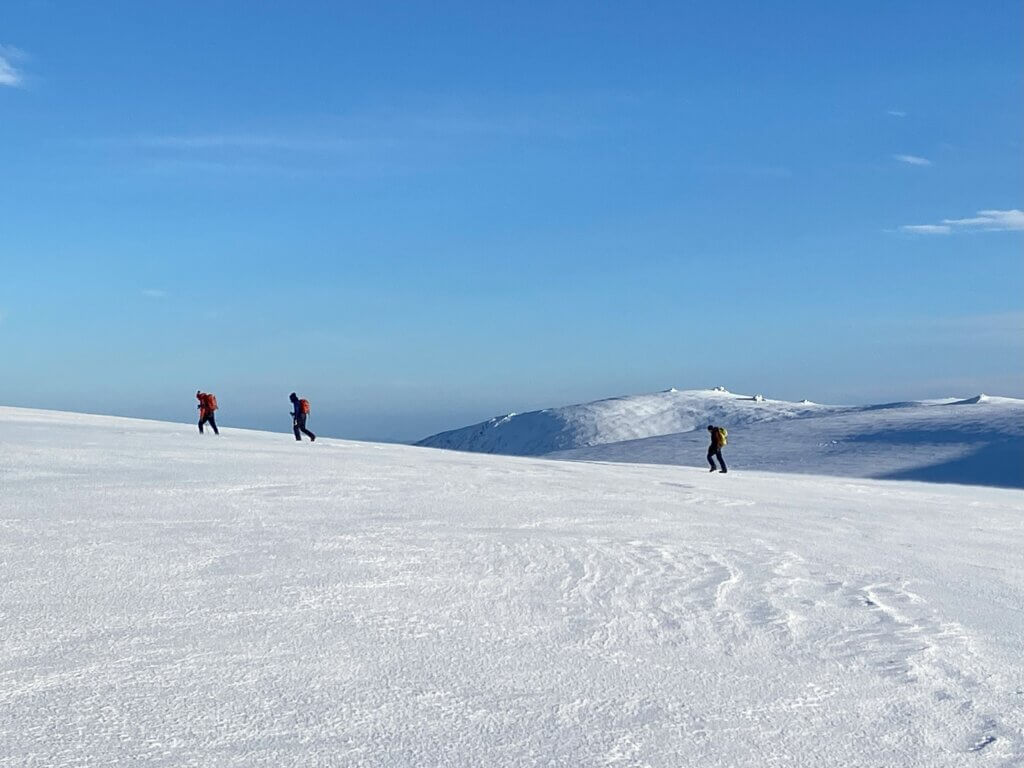
What a view! – New Year Winter Walking 2022 – 2023
The cold temperatures of winter naturally deter many would-be hikers, leaving the trails quieter and more serene. This means fewer crowds and more opportunities to immerse yourself in the solitude of Scotland’s wild spaces. With fewer distractions, you can fully connect with nature, reflect, and appreciate the tranquility of your surroundings. Imagine having iconic trails, like those in the Cairngorms or around Ben Nevis, almost entirely to yourself. It’s an unparalleled chance to experience Scotland’s rugged beauty in its purest form while hiking in winter.
Winter unveils a strikingly different perspective of Scotland’s landscapes. The absence of lush greenery exposes the raw, rugged beauty of the mountains—from dramatic rock formations to stark, snow-covered terrain. If you’re lucky enough to encounter fresh snowfall, the transformation is magical. The pristine white blanket enhances the contours and textures of the land, offering photographers and nature enthusiasts endless inspiration during their winter hikes. Plus, winter often brings incredible sunrises and sunsets that bathe the snow-dusted peaks in hues of gold and pink, perfect for unforgettable photos.
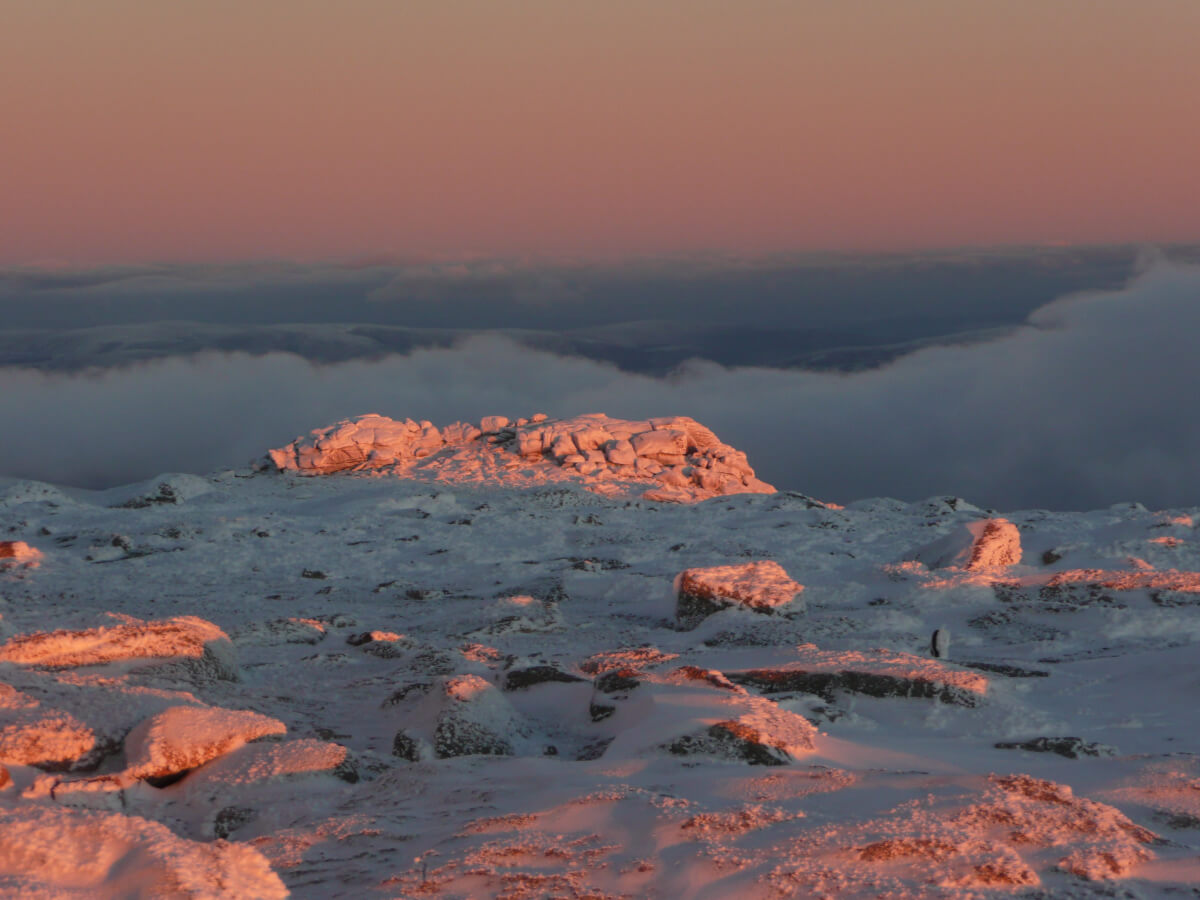
Winter sunset colours glowing on the snow covered Cairngorms
For the fitness-minded adventurer, hiking in winter provides an added bonus: increased calorie burn. The colder temperatures force your body to work harder to stay warm, meaning you’ll burn more calories compared to hiking in warmer weather. Add in the effort of navigating snow-covered paths, and your winter hike becomes an even more rewarding workout. Studies suggest that cold-weather exercise can burn up to 30% more calories, making winter hikes both invigorating and beneficial for your health.
Hiking in winter introduces unique challenges, from navigating icy trails to managing colder temperatures. These added elements demand a different level of preparation and skill, but they also offer an unparalleled sense of achievement. Conquering a winter hike builds confidence and leaves you with stories to share for years to come. Proper preparation—like wearing crampons and layering effectively—can transform these challenges into exciting opportunities to learn new skills. Plus, the sense of adventure and novelty makes every step more exciting.
If you’re ready to challenge yourself, embrace the season, and experience some of the most stunning terrain and views imaginable, hiking in winter in Scotland awaits. With the Cairngorms averaging over 100 days of snow cover per year, it’s one of the best places in the UK to experience a true winter wonderland. Join Scot Mountain Holidays for a guided adventure that will leave you with lasting memories and a newfound appreciation for this extraordinary season.
Setting off on expedition across the snowy Cairngorm plateau
When you think of snow, it’s easy to picture adrenaline-filled days of skiing or snowboarding. But what if you’re not a fan of the slopes or simply want to try something different? Scotland offers a winter wonderland full of thrilling alternatives that let you embrace the snow in unique ways.
Here are Scot Mountain Holidays’ top four snowy adventures for non-skiers, perfect for creating magical winter memories.
Hiking isn’t just a summer activity—winter hiking offers a whole new level of magic. With snow-dusted trails and tranquil, crowd-free paths, it’s the perfect way to experience Scotland’s rugged beauty in its most serene form.
Yes, winter hiking comes with challenges, but the rewards are extraordinary. Picture yourself surrounded by glistening peaks, breathing in crisp mountain air, and savoring the quiet that only snow can bring. Just be sure to bundle up and prepare for the elements!
For those craving adventure with a side of learning, Scot Mountain Holidays offers snow skills courses that are as practical as they are exhilarating.
From mastering ice axes to building emergency snow shelters or navigating icy terrain, these courses give you hands-on experience that’s both empowering and fun. Not only will you leave with stories to tell, but you’ll also pick up life-saving skills that every winter enthusiast should have.
Not every snowy adventure needs to be a grand expedition! Sometimes, the best memories come from simple, joyful moments.
Spend an afternoon building a snowman, crafting the perfect snow angel, or engaging in a good old-fashioned snowball fight. If you’re traveling with kids (or just feeling like one yourself), grab a sled and race down a snowy hill.
End your day by cozying up by a roaring fire with a hot drink and a good book. After all, there’s nothing like the warmth of home after a day of snowy fun.
If you’ve never tried snowshoeing, you’re in for a treat! Imagine strapping on tennis racket-like footwear and gliding effortlessly across snowy trails and frozen terrain. Snowshoeing is easy to learn, beginner-friendly, and a fantastic way to immerse yourself in Scotland’s breathtaking winter scenery. However, the snow conditions on the Scottish hills are not always suitable for snowshoeing which lends itself more to the soft powder snow you find in the Rockies or the Alps. It’s far more common to see winter hikers in Scotland out with crampons and an ice axe, than it is to see a group of snowshoers.
From snow-covered peaks to quiet, magical trails, Scotland is the ultimate destination for winter lovers. With Scot Mountain Holidays, you can enjoy a range of activities designed for adventurers who want to experience the snow without strapping on skis or a snowboard.
So, whether you’re trekking through glistening forests, learning new skills, or simply playing in the snow, Scotland promises a winter escape like no other.
Ready to trade the slopes for something different? Let Scot Mountain Holidays help you craft your perfect snow-filled adventure!

Andy Bateman has instructed and guided for over 25 winter seasons across Scotland. At times its blue skies and a winter wonderland but being based in the Cairngorms he is no stranger to the sometimes uncompromising conditions that can be encountered on Scotland’s high mountains during the winter months.
Putting aside the obvious need to dress properly for the conditions, here are a few of his expert winter skills tips:
Unless your rucksack has a facility specifically for carrying crampons safely on the outside, they should be in a crampon bag inside your rucksack when not on your boots. They are heavy items of kit and can easily work loose when attached with exterior straps or bungee. Crampons carried on the outside can also be a source of injury for other members of the party e.g. in high winds.
The snow and ice conditions can be as varied as the weather that creates them. Don’t limit the techniques at your disposal before you’ve even set foot on the mountain by wearing bendy boots. A key and often overlooked feature of a stiff boot is that it allows you to concentrate your weight on the edges of the sole so you’re able to use them to cut into the snow surface. Your boot is as much a tool as your ice-axe or crampons. B1 “winter” boots are often too flexible to effectively kick steps in hard snow; if you try to front point, the toes tend to bend up and the heel drops causing the wearer to feel unstable. Fully rigid B3 mountaineering boots don’t feel overkill for a winter mountain walk.

Crampons at work
There are a few situations where a long shaft is an advantage but they are outweighed by the number of situations where a short shafted axe is your best bet. Go for an axe with a relatively straight shaft and no longer than 55cm irrespective of your height.
Remember in winter trekking your rucksack will be heavier, plus the extra weight of winter boots and crampons on your feet, the underfoot conditions and having to check the map more frequently all conspire to slow your pace. On top of this there are fewer daylight hours. It’s important that you’re not over ambitious with your route plan to prevent being caught out. Always make sure you have a decent headtorch.
Your rucksack is already heavier with all the necessary gear required by winter. Heavy boots, crampons and underfoot conditions will sap energy and slow you down. Don’t burden yourself further with superfluous kit by considering whether an item is really necessary for the day. At the same time, be sure you have everything you need.
 Full moon Snow-hole Expedition winter gear
Full moon Snow-hole Expedition winter gearEven with an insulated jacket around the tube, once the temperature drops below -3 deg C hydration bladders tend to easily freeze. You are better off with a water bottle in your sack as close to your back as possible to receive a little body heat. Better still take a thermos flask.
There are situations where an ice axe leash is an advantage but there are also a good number of situations where they can be a hazard. Have an arrangement where the leash can be easily added or removed from the head of the axe, i.e. tie a loop in the end of the leash and larks-foot it through the head of the axe. When you aren’t cutting steps or climbing the leash is probably best kept in your rucksack.
Remember, as your core temperature cools your body reduces its circulation to your extremities, like your hands. If you have cold hands, it may well be worth considering putting an extra layer on, as well as warmer gloves. If the body is compensating for a cooling core, to a certain extent, it doesn’t matter how well insulated your hands are, it’s not going to send anymore warm blood to the extremities.
Your body can burn up 40% more calories just by keeping itself warm. Underfoot conditions and heavy gear add to your body’s energy demands. Standing around for more than 10 minutes can mean folks start to get chilled. Schedule-in regular breaks where possible. I find a 10 min break after approximately every 80 min of walking is optimal. You need good judgement and one of the most sensitive organs in your body to a drop in temperature or a lack of energy is your brain. It needs to be well nourished by both.

Striding out to conquer the winter Cairngorms
Why do it? Because this is why it’s worth it.
What does ‘off the beaten track mean to you’? Depending on how adventurous you are, the phrase can mean different things to different people. It can be scary to choose the path less travelled by, but the benefits from getting off the beaten track in Scotland are exhilarating.
But, this certainly doesn’t mean you need to skip all the top sites like Loch Ness. For some, getting out of cities is rural enough and therefore Loch Ness is a great choice. But for those feeling adventurous and wanting to get a little more remote, we can help you there.
Wanting to find a little peace and quiet is the most natural thing in the world whether you’re most at home surrounded by nature, a city dweller or somewhere in between. And arguably, there is no better place than the Highlands of Scotland. Known for its epic beauty, contrasting scenery and out of this world views, you’ll soon find yourself where the air and water are fresher and the most prominent noises keeping you company is nature at its finest.
The Cairngorm National Park is the ideal base for you to experience and explore the remoteness the Highlands can offer. Depending how far off the beaten track you want to get you’ll find an array of options suited for all fitness levels and ages. Offering options to be guided, or self exploration if you prefer, Scot Mountain Holidays has it all.
We understand that only you know what getting off the beaten track means. But, Scot Mountain Holiday trips, by definition are all off the beaten track. It’s unlikely you’ll see crowds of people during any typical day with us. Choosing one of our trips is a great way to decide if the more unusual spots and a more active vacation is the way forward for you.
Whether you’re after hiking, mountain biking, walking or countryside relaxation, you’ll find it here. We can help organise a tailor-made trip for you, friends and family. Or, you can join one of our scheduled trips where you’ll meet like-minded people and gain friends for life. The choice is yours.
COVID and retirement plans have created complete havoc in the cafe market here. Our list of cafes is now seriously outdated and we’ve been forced to revise it completely as when re-reading the list in October 2021, we noticed that at least half of the recommended cafes have now closed. Watch this space over the next week or so and we’ll give you the new improved list.
Graeme McLean of Developing Mountain Biking in Scotland recently described Aviemore to me as having a “cycle culture”. At the time this meant nothing to me, until they went on to explain that when you visit Aviemore you become seduced into cycling just because it seems to be the thing to do. When everyone else seems to be cycling around this must mean that it is the thing to do. Hence in our area it is not difficult to come up with a list of cyclist friendly cafes.
Certainly here at Fraoch Lodge we have noticed a definite increase in the number of people driving around the area with bikes mounted on the car and also a definite increase of bike use on the tracks.
These are the cafes we are most familiar with and are therefore almost all on the north side of the Cairngorms, in and around Aviemore. However, we will be in Deeside for a week in July and will be very happy to update our list after 16th July with some additions from Braemar, Ballater etc – if we find anything which meets our criteria: superb food (especially cakes), somewhere to safely leave your bike locked, somewhere to work on your bike, bike/cycling route advice, bike/cycling related reading materials, maps for sale.
After consultation with my fellow members of Petal Power (the Cairngorms area female mountain biking group), I’ve come up with the following list.
Listed in order of their proximity to Fraoch Lodge:
The Osprey Coffee House has come on in leaps and bounds since it re-opened after Covid. It is now owned and managed by Andreas and Tanya Perch. The Perches have plenty of Coffee Shop experience having previously run their own enterprise in Val d’Isere (French Alps). They offer soup as well as “Fika” (coffee and cake, Swedish style).
Routes close by: Speyside Way, Burma Road, Ryvoan Pass plus numerous local routes through the woods, Woodland Wheels (Boat of Garten pump track)
Unfortunately Nethy House is currently up for sale but it is a highlight of any route in the area. They get any meat they need for their lunch options from Balliefurth Farm Shop next door (the highest quality of meat). Cairngorms Connect venison is also available through the butchers at the farm shop. If you eat meat, certainly make the time to fit in a visit.
Routes nearby: Speyside Way, Abernethy Forest, Forest Lodge, Ryvoan Pass, plenty of forest routes and Rynettin also a highlight
Delicious smells were emanating from the door when I went by to take a peek at the menu. Great selection of hot food. The Cullen Skink is exceptional and the cakes are very hard to resist, especially the cheesecake.
Recommended by Petal Power
Routes nearby: Burma Road, Tomatin on Route 7, off road route to Boat of Garten via Route 7
Despite it’s proxmity to Mike’s Bikes, I have yet to sample the delights of Ryvoan Cafe personally, but I have had universally good reports from friends who have been there.
Under the personal supervision of owners, Nina and Daniel, Ryvoan Cafe isn’t just Aviemore’s latest neighbourhood deli-cafe – they’re passionate about creating a warm and inviting space where you can unwind and indulge.
“Our menus are carefully crafted to delight your palate with simplicity and finesse. We embrace the ever-changing seasons, incorporating locally sourced ingredients for an authentic and memorable dining experience. From sophisticated snacks and charcuterie to be shared, perfectly complemented by our selection of organic wines, to drinks and dining that draw visitors from far and wide.”
Routes close by: Rothiemurchus estate, Lairig Ghru, Glen Feshie and Glenmore to Inshriach
(Petal Power comments) Inschriach Nursery Cafe have always been very welcoming, even when wet and muddy.
The Barn does take away cake etc as well as eat in. There is usually plenty of choice and there is the Rothiemurchus shop just across the car park if you’re looking for any treats to take home. Meat from the estate is also sold there.
Routes nearby: Burma Road, Loch an Eilean, Rothiemurchus estate, Speyside Way, Badenoch Way, Glenn Einich
 Plenty of imaginative cake options at the Mountain Cafe. This particular cake is one of ours but the Mountain Cafe has spectacular offerings too.
Plenty of imaginative cake options at the Mountain Cafe. This particular cake is one of ours but the Mountain Cafe has spectacular offerings too.Another popular spot right next to Glenmore campsite and very convenient if you’re looping around Loch Morlich or more widely through Rothiemurchus estate or the Ryvoan pass. They have a bar but also do a roaring trade in coffee, hot chocolate and hot food plus they have a wee shop attached if you just want a snack. If you’re lucky enough to be out for a late ride you might even catch some of the live entertainment.
Routes nearby: Ryvoan pass, Glenmore Forest Park, Loch Morlich
One of my favourite places to stop if I’m ever over this way. I just love the atmosphere and Tony himself (owner and front of house) is a keen cyclist too. They go the extra mile for cyclists for sure. There isn’t a massively extensive menu but everything they offer is top quality and reflects their Italian heritage. Ann Vastano (co-owner of the cafe) is a renowned local artist who sells prints and cards of her work, alongside the orginals displayed in the cafe.
Being a purpose built MTB centre, the Coffee Still at Glenlivet ticks all the best practice boxes. Currently run by the owners of Nethy House. There are bike racks, wee track to keep the kids happy, trail maps for sale, bike hire available, range of food – not only cakes but hot food like pizza and burgers too. The trails are great too and very family friendly.
Routes nearby: Glenlivet MTB trails, Glenlivet Distillery routes, Kinkardine Hills, Ladder Hills
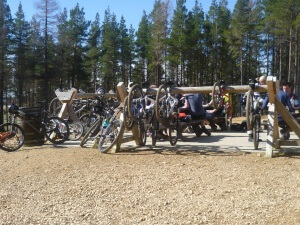 The Coffee Still at Glenlivet MTB trails – right next to a wee practice track which keeps the kids occupied while waiting for your order to arrive.
The Coffee Still at Glenlivet MTB trails – right next to a wee practice track which keeps the kids occupied while waiting for your order to arrive.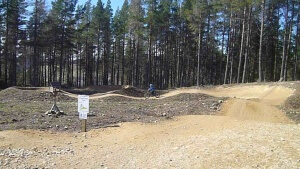 Humps and Bumps to keep the kids keen while the food is being cooked in true Slow Food tradition from the best of local ingredients. (Glenlivet MTB Trails)
Humps and Bumps to keep the kids keen while the food is being cooked in true Slow Food tradition from the best of local ingredients. (Glenlivet MTB Trails)
Not forgetting the south side of the park (nominated by Petal Power, an all-female mountain biking club in the Cairngorms, centred around Aviemore and Nethybridge)
The Bothy is an excellent relaxing spot attached to Braemar Mountain Sports. Bikes can be hired here and the back of the cafe looks out over the river. The cakes and hot chocolate also deserve some praise. Plenty of choice at the cake bar.
Honorary mentions nearby the Cairngorms
Linda, who runs the Pottery cafe and bunkhouse, has been baking bread and cake for more years than she cares to count. Her cakes are always light and the soup is delicious. The cafe is a hop-skip-and-a-jump from Laggan Wolftrax and though I haven’t eaten at Laggan so I can’t compare the two – Linda’s opening hours were longer and she’s open all year round. When I was at Laggan (before the main season opened) the cafe was closed.
Routes nearby: Laggan Wolftrax
2. Olive Tree Cafe (Logie Steading) – on the Dava Way, just outside Forres
Logie Steading is a collection of up-market operators selling all kinds of things from second-hand books to plants to pictures and not forgetting food. You can also catch up with
From the Daily Record: Top cycle friendly cafes in Scotland
http://www.skinnytyres.com/2010/10/14/great-cycling-cafes-is-scotland/
4o
there are trails all round the area plus several centres with purpose-built tracks like Laggan Wolftrax and Glenlivet Bike Trails. Bikes can be hired from Mikes Bikes or Bothy Bikes in Aviemore.
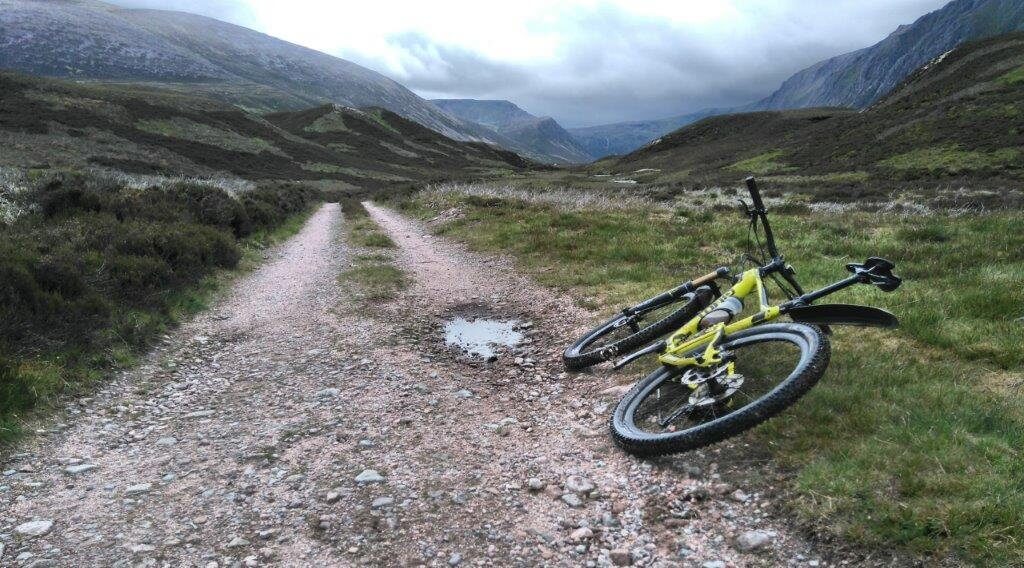
Enjoy the wild parts of the UK out on your bike
with G2 on the Alvie Estate.
Aviemore has a community ice skating rink again and you can also use the all weather rink at Loch Insh
you could take the public bus to Boat of Garten (5 miles) or Nethybridge (8 miles) and walk back to Aviemore stopping in the Old Bridge Inn for a pint on your return.
and paddle the Spey;
canoe with the Moray Firth dolphins or kayak/canoe on Loch Ness.
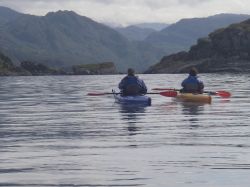
Water based options might not be as appealing as you think, but water is surprisingly warm in the winter.
a tour to Loch Ness is a popular option for our guests at Fraoch Lodge
and check out the Findhorn Foundation or visit the Kimberley Inn for lunch and walk along the white sands of the beach.
and try out ice skating.
unfortunately the Aviemore pool at the Macdonald’s resort is not currently available to the public for swimming.
and tour a distillery plus visit the Cooperage
Always a wet or cold day option – a distillery visit or whisky tasting.
or Johnston’s wool mill in Elgin if Knockando is closed. Tours are every hour until 3 or 4pm and are free of charge.
where you can experience the whole wool story from shorn fleece to completed material.
Get crafty if you’d like some time and space to knit, ask Rebecca for recommendations
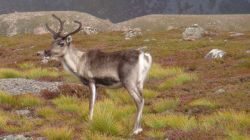
If you like to see reindeer, you should come to Aviemore, particularly in the winter which is their natural habitat.
and/or the Highland Folk Museum
Traditional village which is part of the Newtonmore Highland Folk Museum
New website for the Cairngorms National park highlighting selected experiences within the park – cairngormsnationalpark.co.uk
All content © Copyright Scot Mountain Holidays 2025
Responsive web design by Summit Web Solutions